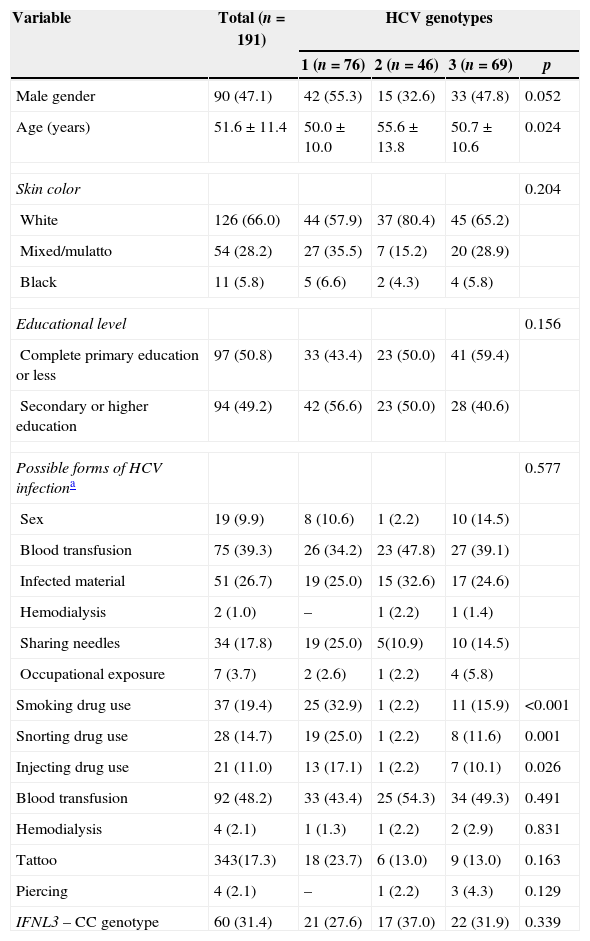Hepatitis C virus (HCV) infection is a global health problem and approximately 80% of the patients develop chronic hepatitis C, which can progress to liver cirrhosis and hepatocellular carcinoma. HCV genotype is a classical predictor of the success of the standard treatment (interferon-α in combination with ribavirin). HCV genotype 1 carriers have usually a lower rate of response than patients infected with HCV genotypes 2 and 3.1 Human single nucleotide polymorphisms near the gene for interferon-λ3 (IFNL3; formerly known as IL28B) were also recently associated with spontaneous HCV clearance and sustained response to interferon-based therapy.2 The present study aimed to determine the frequency of the HCV and IFNL3 genotypes in hepatitis C patients from the North region of Rio Grande do Sul state, Southern Brazil.
Adult individuals with chronic hepatitis C attended in referral services for patient care in Passo Fundo (a medium-sized urban center in the North region of Rio Grande do Sul state) were selected from August 2010 to July 2011. Socio-demographic data were obtained from a structured questionnaire and patient medical records were reviewed to obtain clinical and virological information. IFNL3-molecular analysis was performed as previously described.2 The study was approved by the Research Ethics Committee of the Universidade Luterana do Brasil (ULBRA).
A total of 191 HCV-infected patients were included in the study. Patients were predominantly female (52.9%) and had a mean age of 51.6±11.4 years. Approximately half of the participants (n=92, 48.2%) received blood transfusions and 75 patients (39.3%) reported that this condition was the possible HCV transmission route. Use of sharp objects (26.7%) and needle sharing (17.8%) were also cited as possible transmission factors. HCV genotype 1 was found in 76 (39.8%), genotype 2 in 46 (24.1%) and genotype 3 in 69 patients (36.1%). HCV genotype 1 was significantly more often in users of illicit drugs, while genotype 2 was more frequently found in women and old people. Sixty patients (31.4%) showed the CC, 97 (50.8%) CT and 34 (17.8%) TT IFNL3 genotypes (Table 1).
Distribution of socio-demographic and epidemiological characteristics in patients stratified according to HCV genotypes.
| Variable | Total (n=191) | HCV genotypes | |||
|---|---|---|---|---|---|
| 1 (n=76) | 2 (n=46) | 3 (n=69) | p | ||
| Male gender | 90 (47.1) | 42 (55.3) | 15 (32.6) | 33 (47.8) | 0.052 |
| Age (years) | 51.6±11.4 | 50.0±10.0 | 55.6±13.8 | 50.7±10.6 | 0.024 |
| Skin color | 0.204 | ||||
| White | 126 (66.0) | 44 (57.9) | 37 (80.4) | 45 (65.2) | |
| Mixed/mulatto | 54 (28.2) | 27 (35.5) | 7 (15.2) | 20 (28.9) | |
| Black | 11 (5.8) | 5 (6.6) | 2 (4.3) | 4 (5.8) | |
| Educational level | 0.156 | ||||
| Complete primary education or less | 97 (50.8) | 33 (43.4) | 23 (50.0) | 41 (59.4) | |
| Secondary or higher education | 94 (49.2) | 42 (56.6) | 23 (50.0) | 28 (40.6) | |
| Possible forms of HCV infectiona | 0.577 | ||||
| Sex | 19 (9.9) | 8 (10.6) | 1 (2.2) | 10 (14.5) | |
| Blood transfusion | 75 (39.3) | 26 (34.2) | 23 (47.8) | 27 (39.1) | |
| Infected material | 51 (26.7) | 19 (25.0) | 15 (32.6) | 17 (24.6) | |
| Hemodialysis | 2 (1.0) | – | 1 (2.2) | 1 (1.4) | |
| Sharing needles | 34 (17.8) | 19 (25.0) | 5(10.9) | 10 (14.5) | |
| Occupational exposure | 7 (3.7) | 2 (2.6) | 1 (2.2) | 4 (5.8) | |
| Smoking drug use | 37 (19.4) | 25 (32.9) | 1 (2.2) | 11 (15.9) | <0.001 |
| Snorting drug use | 28 (14.7) | 19 (25.0) | 1 (2.2) | 8 (11.6) | 0.001 |
| Injecting drug use | 21 (11.0) | 13 (17.1) | 1 (2.2) | 7 (10.1) | 0.026 |
| Blood transfusion | 92 (48.2) | 33 (43.4) | 25 (54.3) | 34 (49.3) | 0.491 |
| Hemodialysis | 4 (2.1) | 1 (1.3) | 1 (2.2) | 2 (2.9) | 0.831 |
| Tattoo | 343(17.3) | 18 (23.7) | 6 (13.0) | 9 (13.0) | 0.163 |
| Piercing | 4 (2.1) | – | 1 (2.2) | 3 (4.3) | 0.129 |
| IFNL3 – CC genotype | 60 (31.4) | 21 (27.6) | 17 (37.0) | 22 (31.9) | 0.339 |
Variables expressed as number (percentage) or mean±standard deviation.
Some HCV genotypes have a restricted geographical distribution (genotypes 4-6), while others (genotypes 1-3) are more broadly disseminated. HCV genotype 1 is the most prevalent in the world.1 In the present study, genotype 1 was also demonstrated in the highest frequency, followed by genotypes 3 and 2, respectively. Other studies in Brazil have also shown the occurrence of these three genotypes, but genotype 1 with frequencies over 60%, while genotype 2 lower than 10%.3,4 This unusual high frequency of HCV genotype 2 confirms the results observed in a previous study.5 In the present report it was further demonstrated the high proportion of old women infected with this genotype. IFNL3 CC genotype, a good human prognostic factor of treatment outcome, was also found in a percentage similar to other Brazilian study.2
In conclusion, the data obtained in the present study have shown a high frequency of HCV genotype 2 in an urban center in Southern Brazil and suggest the HCV genotypes could have different transmission routes.
Conflicts of interestThe authors declare no conflicts of interest.





